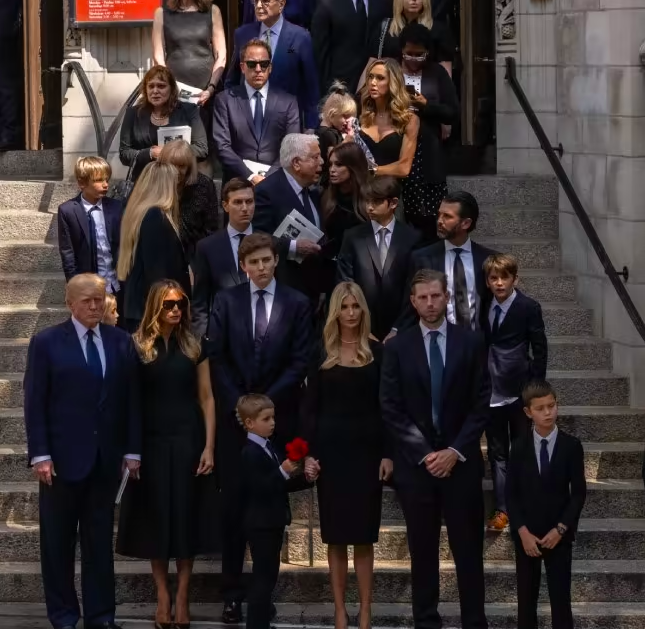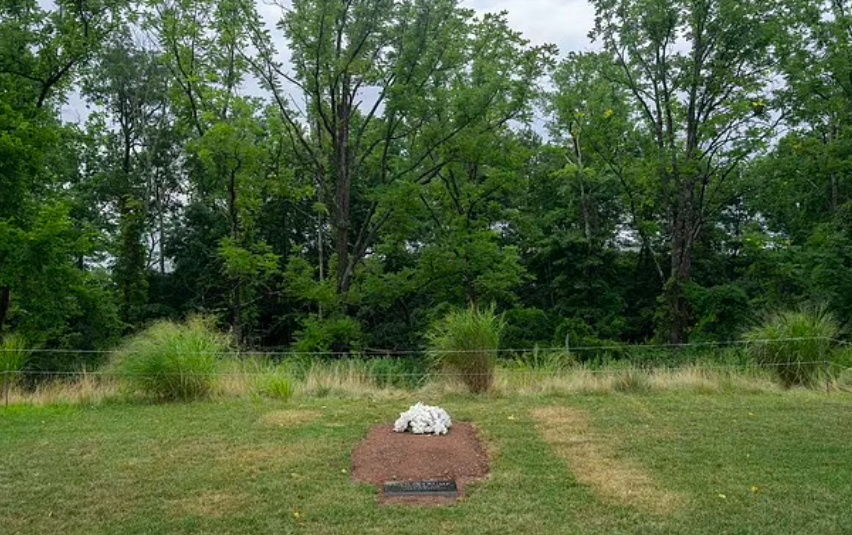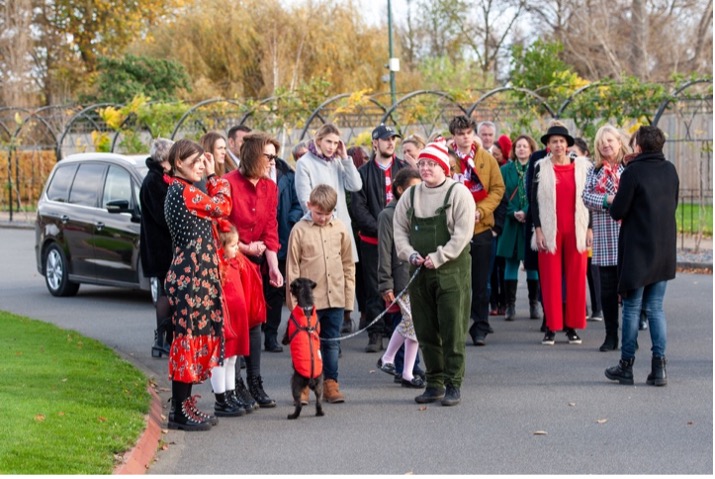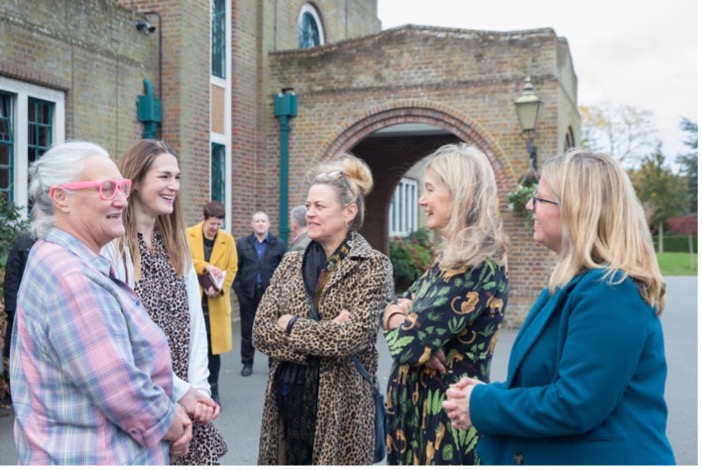
Recent photographs of the former President Trump and his family solemnly lining the steps of the Church of St. Vincent Ferrer in New York City, watching Ivana Trump’s $125,000 ‘golden hued casket’ as it was carried to the waiting hearse offer us absolute visual confirmation of what the Western world deems to be appropriate ‘attire’ at a funeral.
It’s not clear whether the wall-to-wall sea of black and navy suits looked quite so appropriate as Ivana’s casket was lowered into the solitary grave by the first tee at Trump’s Bedminster Golf Club, apparently endowing Trump with a ‘huge tax break’ by effectively turning the golf club into a cemetery in the process.

Anyway. We were recently struck by the advice offered by the big players in the UK funeral sector telling people what they should wear to a funeral. On their websites. With what appears to be all due solemnity. As if there’s a public service being offered by guiding people towards an important social imperative of funeral etiquette.
Firstly, we wondered exactly who would be looking to the likes of Dignity Funerals, Co-operative Funeralcare and Funeral Partners for guidance?
Check with the family of the person who has died, by all means. If the family want a particular dress code or theme to a funeral, then you can be sure that this will be communicated to guests. If in doubt, ask a family member, or the celebrant, or the funeral arranger involved. It is, we would suggest, unlikely that many people would log on to a corporate funeral director’s website for advice.
There can’t be many adults in the country who aren’t able to decide for themselves what to wear to any given event, and goodness knows there are enough examples of funerals on TV, on the news, in films – and just in general life – to indicate what people at funerals usually wear. For the big players to bestow their learned advice on the public seems both paternalistic and patronising, and, we would suggest, not a little self-interested.
There is a vested interest for the largest funeral companies to ensure that in 2022, funerals continue to look the same as they did in 1922; the big black shiny cars, the outdated Victorian garb of the funeral director complete with hat and waistcoat identifiable as the master of ceremonies, the sombre men in black jackets and grey striped trousers silently shouldering a coffin bedecked with a ‘floral tribute’ – and assembled ranks of mourners in black clothing completing this picture of how a funeral ‘should’ look.
For some families, a traditional look to a funeral is absolutely what they want, and we are not in any way criticising this. There are all sorts of reasons for preference at a funeral, we just don’t think that funeral directors’ guides to etiquette should be arbiters of taste. That’s the role for the family involved.
For other families, all that is needed is an awareness that there is no right or wrong – freed from the expectations of others, many people might choose a very different look to the funeral ceremony they are organising. A good funeral director will support and encourage this, but unfortunately, many families who have engaged a funeral company that is part of a large chain might not experience a similar freedom.
The big players in the funeral industry aren’t interested in creativity or self-expression at a funeral. A funeral conductor with a colourful pocket handkerchief or bearers in different colour ties or the offer of an ‘alternative hearse’ – this is about the extent of what the large corporates can offer clients, while everything else slots in to ‘service as usual’.
Guests might be invited to wear something colourful if the person who died had a favourite colour, but for the vast, vast majority of funerals there appears to still be an expectation that mourners will arrive wearing traditional ‘respectful’ formal black clothes. And while this might be a cultural norm for some, and very much expected in some communities, in an increasingly secular society, changes are happening.
Secondly, the advice from the big players in funeralworld reads as if they have all tried to edit and individualise a single original archaic document.
Dignity Funerals sternly admonish:
“Do not wear any of the following to a funeral:
- Revealing or suggestive clothing
- Trainers or flip flops
- Printed t-shirts
- Jeans
- Caps
- Colourful ties
- Excessive amounts of jewellery”
Co-operative Funeralcare are a little more generous but have similar warnings:
“If the family have requested bright colours or a particular theme, then of course this is fine, but in most cases it’s best to avoid:
- Jeans
- Short sleeved shirts
- Revealing clothing
- Flip flops or trainers
- Football shirts/sportswear
- Caps
- T shirts
- Clothing with logos or branding
- Flashy jewellery”
Funeral Partners are more subtle, including detailed advice for women, men, children and toddlers (!) in a heavily loaded piece with lots of emphasis on ‘smart’ and recommendations to avoid ‘jeans, revealing clothing, flashy jewellery and hats’ (for women), and ‘jeans, short-sleeved shirts, trainers and caps/beanies’ for men.
It seems that the three main funeral providers in the UK are united in their approach to ensuring that gatherings of mourners at funerals are all dressed ‘appropriately’ by issuing their opinions so strongly:
Don’t, whatever you do, wear jeans to a funeral. Or a cap. Or the peculiarly judged ‘flashy jewellery’. Presumably, according to this guidance, if you were foolish or rebellious enough to do so, something terrible would happen. Everyone would know you were deliberately showing ‘disrespect’ to the person who has died, or their family. You would upset someone. You’d be shown up for the social outcast you obviously are. Didn’t you read the guide to funeral etiquette on the funeral director’s helpful website? Don’t you understand what is APPROPRIATE???
The funeral companies sprinkle references to what is ‘appropriate’ throughout their ‘what to wear’ guides, ladling on a heavy sense of obligation to get it right. We would respectfully ask, who gets to decide what is appropriate or not? Ever? Definitely not the people dressed up like Goth tribute acts with top hats, fob watches and canes, or their colleagues who sit in their ‘funeral homes’ ‘attired’ like bank clerks under the company uniform code enforced by their managers.
We view these guides with a similar level of weariness as we have for the stock photos of funerals regularly used to illustrate press articles – they’re just out of date and irrelevant. And unnecessary. They serve only to shore up the funeral directors’ over inflated sense of their own importance, setting themselves as the advice-bestowing arbiters of taste.
They reflect funerals as they were, not how they are. They don’t reflect the changing face of funerals, the diversity of our society, the emergence of awareness that funerals are whatever people want them to be. The begrudging references to ‘it’s best to check the wishes of the bereaved family’ heavily imply that anything other than following the etiquette outlined is an aberration, an exception to the traditional rules, which are so much more comfortable and preferable, so much more ‘appropriate’.
And infuriatingly, as well as being outdated, these guides are poorly written and pompous in tone – see some examples below:
“If you are unsure of what to wear, it’s important to be respectful to the deceased.” (what does this even mean??)
“By wearing casual clothes, you could be unintentionally sending the message that you don’t care about the person who has died”
“Black clothing isn’t always compulsory for women but it is best to wear a dark coloured skirt, dress or pair of trousers”.
The Funeral Partners website is the only one of the three to acknowledge that some cultures differ in what people are expected to wear to a funeral, noting that wearing black is not considered appropriate (there’s that word again) at a Hindu funeral or a Sikh funeral.
Whoever wrote this particular piece then goes on to helpfully describe ‘some other popular colours worn worldwide’, telling us that ‘in South Africa, red is sometimes worn as a colour of mourning’, that in Thailand ‘purple represents sorrow and is often worn by widows during the mourning period’ and, perhaps the most irrelevant inclusion, ‘in Papua New Guinea a widow applies a stone-coloured clay to their skin while mourning their husband.’ All very interesting, but of absolutely no help to a reader wondering whether they are ok to wear their navy suit to go to their neighbour’s funeral in Clacton. It’s almost as if someone got overexcited and embellished their boring ‘wear black to a funeral’ article with some gems from Wikipedia.
We think that it’s ridiculous, in this day and age, to be telling people what ‘etiquette’ dictates that they should be wearing to any event. ‘Etiquette’ is defined as ‘the social set of rules that control accepted behaviour in particular social groups or social situations’ – an invisible ‘code of conduct’ that serves to ensure people feel either part of a group or an excluded other who doesn’t conform.
Etiquette is associated with the constructs of the British social class system, the status hierarchy of the ‘genteel’ upper classes and the ‘coarse’ lower classes, reflecting and encapsulating the conventional norms of the former. In the mid 18th century, the adoption of etiquette was a self-conscious process for acquiring the conventions of politeness and the normative behaviours (charm, manners, demeanour) which symbolically identified the person as a genteel member of the upper class.
In order to identify with the social élite, the upwardly mobile middle class and the bourgeoisie adopted the behaviours and the artistic preferences of the upper class. To that end, socially ambitious people of the middle classes occupied themselves with learning, knowing, and practising the rules of social etiquette, adopting mannerisms, vocabulary – and dress. This is where the roots of the bizarre ‘Guides to Funeral Etiquette’ originate from.
We would suggest that, almost 300 years on, as British society undergoes enormous change and adaptation, embracing diversity and difference, as the control of the church diminishes and the deference to the social constructs of the upper class fades away, there is no place for out-dated aping of the manners and foibles of the richest in society.
Funerals of the rich and famous follow a set pattern, based on historic traditions and expected patterns, and these serve to reinforce the unspoken class system we all live amidst. Harking back to Victorian foppery in the spectacle of the public display of mourning serves nobody well. Apart from the companies who have invested millions of pounds in providing the foppery props, of course.
Wear what you like to a funeral. It’s your presence that matters, not whether you are wearing jeans and flipflops and your flashiest jewellery rather than deepest black crepe and a veil. The person who has died won’t care. And if you meant something to that person, then their family won’t care either. They’ll just be glad to have you there.
Also, you might have a small sense of satisfaction at not being dressed like a member of the Trump family.



